-
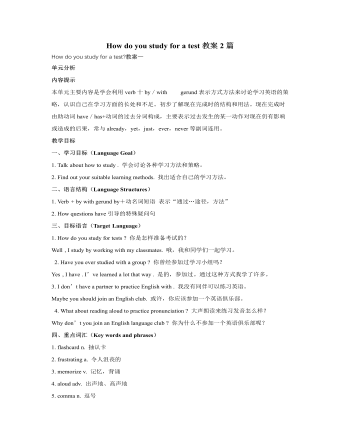
人教版新目标初中英语九年级上册How do you study for a test教案2篇
内容提示本单元主要内容是学会利用verb十by/with gerund表示方式方法来讨论学习英语的策略,认识自己在学习方面的长处和不足。初步了解现在完成时的结构和用法。现在完成时由助动词have/has+动词的过去分词构成,主要表示过去发生的某一动作对现在仍有影响或造成的后果,常与already,yet,just,ever,never等副词连用。教学目标一、学习目标(Language Goal) 1. Talk about how to study . 学会讨论各种学习方法和策略。2. Find out your suitable learning methods. 找出适合自己的学习方法。 二、语言结构(Language Structures) 1. Verb + by with gerund by+动名词短语 表示“通过…途径,方法” 2. How questions have引导的特殊疑问句 三、目标语言(Target Language) 1. How do you study for tests ? 你是怎样准备考试的?Well , I study by working with my classmates. 哦,我和同学们一起学习。2. Have you ever studied with a group ? 你曾经参加过学习小组吗?Yes , I have . I’ve learned a lot that way . 是的,参加过。通过这种方式我学了许多。
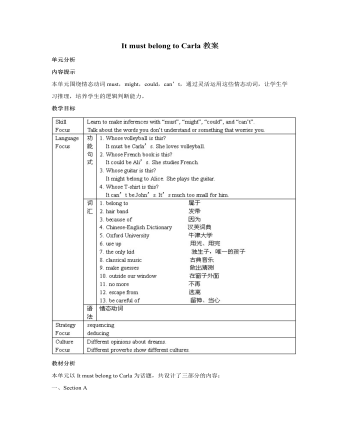
人教版新目标初中英语九年级上册It must belong to Carla教案
一、Section A该部分有4个模块。第一模块围绕Whose volleyball is this? 这一话题展开思维( 1a)、听力(1b)、口语( 1c)训练;第二模块围绕上一模块中的话题进行听力( 2a-2b)、口语训练( 2c);第三模块继续围绕前两个模块中的“making inferences”展开训练。训练形式为阅读排序( 3a)和两人问答(3b);第四模块仍就上一话题展开讨论。二、Section B该部分有4个模块。第一模块要求根据图画和所提供的单词写出合理的句子;第二模块在听力( 2a-2b)和分角色口语训练( 2c)的基础上,继续进行“推测”训练; 第三模块围绕“Strange events in Bell Tower neighborhood”这一话题展开阅读( 3a)和写作(3b -3c)训练;第四模块以dream为话题展开小组活动。三、Self Check该部分有3个模块。第一模块以填空形式对所学词汇进行训练;第二模块就8个谚语展开阅读和讨论。
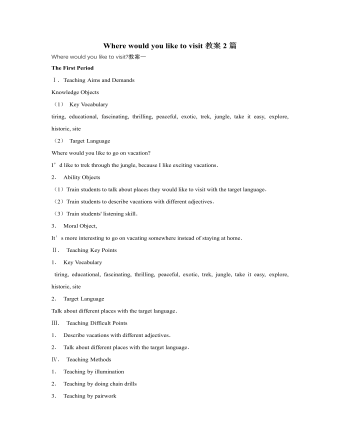
人教版新目标初中英语九年级上册Where would you like to visit教案2篇
The First PeriodⅠ.Teaching Aims and DemandsKnowledge Objects(1) Key Vocabularytiring, educational, fascinating, thrilling, peaceful, exotic, trek, jungle, take it easy, explore, historic, site(2) Target LanguageWhere would you like to go on vacation?I’d like to trek through the jungle, because I like exciting vacations.2. Ability Objects(1)Train students to talk about places they would like to visit with the target language.(2)Train students to describe vacations with different adjectives.(3)Train students' listening skill.3. Moral Object,It′s more interesting to go on vacating somewhere instead of staying at home.Ⅱ. Teaching Key Points1. Key Vocabularytiring, educational, fascinating, thrilling, peaceful, exotic, trek, jungle, take it easy, explore, historic, site2. Target LanguageTalk about different places with the target language.Ⅲ. Teaching Difficult Points1. Describe vacations with different adjectives.2. Talk about different places with the target language.Ⅳ. Teaching Methods1. Teaching by illumination2. Teaching by doing chain drills3. Teaching by pairworkⅤ. Teaching Aids1. A tape recorder2. Some pictures of different places with famous views
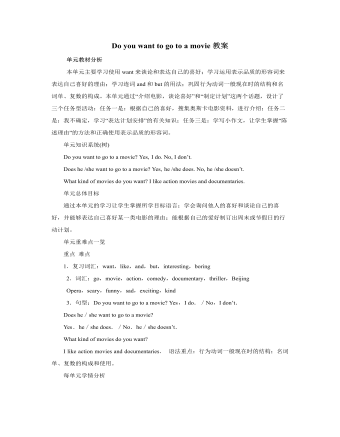
人教版新目标初中英语七年级上册Do you want to go to a movie教案
讨论喜欢的影视类型及理由:在看过一部影视作品后,大家总是喜欢在一起谈论影视的主要内容、主要情节、主要演员主题歌曲、主题音乐等,互相介绍自己对该影视的看法。教师可以组织一次活动,分组讨论学生喜欢看什么类型的电影,并说明喜欢的理由。运用I like…I don’t like…Because it is…等语言结构;然后每个组选派一名代表向全班学生阐述本组组员喜欢观看的电影类型;最后汇总,总结出全班同学最喜欢观看哪一种类型的电影。如果有可能,根据学生的选择放一部(一段)这种类型的影视节目。通过学生的讨论、调查,使他们在完成任务的过程中学会询问和陈述自己或别人在影视方面的喜好及理由,更好地巩固所学内容。Self Check教学内容Self Check(教材P58)教学目标知识与能力复习词汇go,movie,action,comedy,documentary,thriller,and,but,scary,funny, sad,exciting;引导学生复习、巩固“制订计划和打算并谈论喜好和偏爱”的目标语言。

人教版新目标初中英语七年级上册How much are these pants教案
个性练习设计 阅读广告:在日常生活中,人们去买东西之前,一般要阅读广告,从广告中获取该商品的一些有用信息,包括价格、性能等。所以给学生提供有些商品的广告或让学生去商店去阅读一些商品的广告,从中获取商品的价格,即可以锻炼学生的阅读能力,又能提高实践能力。 Self Check 教学内容 Self Check(教材P42) 教学目标 知识与能力 复习词汇pant,sock,T-shirt,sweater,shoes,color,black,white,red,green,blue,big,short,long,数字10--31; 学习词汇Zig Zag,clothes,shop,yellow,ask,which;学会谈论服装的价格、颜色、大小和长短;学会填写价格标签。 过程与方法 运用Summarizing和Classifying的学习策略。在复习教学中,运用听写、绘画、互相询问调查与检测等手段,促使学生不断地使用所学内容,从而提高他们灵活运用知识的能力。 情感态度价值观 该部分学习内容主要是复习谈论服装的价格和颜色以及对服装的喜好,能引起学生的共鸣;通过购物的对话练习教学生学会购物时使用的礼貌用语和如何感谢人。
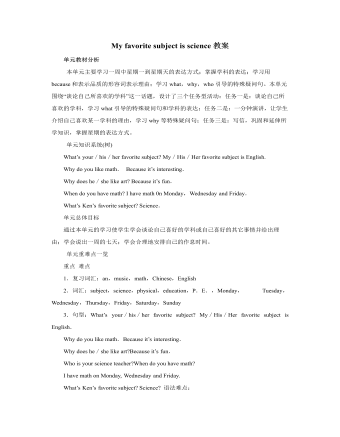
人教版新目标初中英语七年级上册My favorite subject is science教案
本单元主要学习一周中星期一到星期天的表达方式;掌握学科的表达;学习用because和表示品质的形容词表示理由;学习what,why,who引导的特殊疑问句。本单元围绕“谈论自己所喜欢的学科”这一话题,设计了三个任务型活动:任务一是:谈论自己所喜欢的学科,学习what引导的特殊疑问句和学科的表达;任务二是:一分钟演讲,让学生介绍自己喜欢某一学科的理由,学习why等特殊疑问句;任务三是:写信,巩固和延伸所学知识,掌握星期的表达方式。单元知识系统(树)What’s your/his/her favorite subject? My/His/Her favorite subject is English.Why do you like math. Because it’s interesting.Why does he/she like art? Because it’s fun.When do you have math? I have math 0n Monday,Wednesday and Friday.What’s Ken’s favorite subject? Science.单元总体目标通过本单元的学习使学生学会谈论自己喜好的学科或自己喜好的其它事情并给出理由;学会说出一周的七天;学会合理地安排自己的作息时间。

人教版新目标初中英语七年级上册What time do you go to school教案
知识与能力复习词汇time,morning,breakfast,get up,g0 t0 bed,homework,clock,afternoon,lunch,run,watch TV,evening,dinner,eat,usually,o’clock,thirty,fifteen,take a shower,go t0 school等;引导学生复习、巩固“询问和谈论时间”的目标语言并运用所学知识安排自己的学习和课外活动。过程与方法运用Summarizing,Classifying和Comparing的学习策略。在复习教学中,运用听写、提问、对话演练与调查活动,促使学生不断地使用所学内容,从而提高他们灵活运用知识的能力。情感态度价值观本部分的主要内容是复习“日常作息时间”的询问和表达。通过互相询问或谈论自己或对方的作息时间安排和活动计划,培养学生良好的作息习惯和守时习惯。教学重、难点及教学突破重点复习词汇time,morning,breakfast,get up,g0 to bed,homework,clock,afternoon,lunch,run,watch TV,evening,dinner,eat,usually,o’clock,thirty,fifteen,take a shower,go to school等;引导学生复习、巩固“询问和谈论时间”的目标语言。
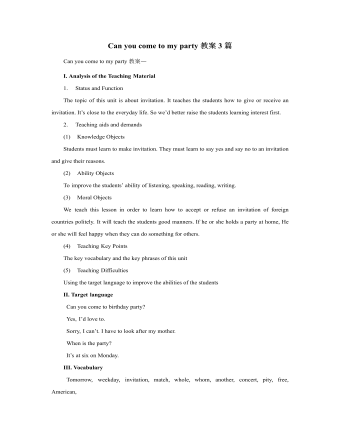
人教版新目标初中英语八年级上册Can you come to my party教案3篇
Step 3 (3b)First, tell the students when we talk about our future plans, we often use: I’m+verb+ing When we talk about what we must do, we use have to. Ask the students to fill in the blanks in 3b. The answers are: shopping, go to see, a test, I’m going, my family. Step 4 (3c)Let the students write an e-mail message to a friend. Say why you can’t visit next. Before the exercise, ask the students to give some possible answers and write them on the blackboard. So the students will feel easy to finish the writing exercise. After they finish it, Let them to correct it in groups first. Each group chooses theirs best one to read in front of the whole class. Step 5 ( planning a party )First read the conversation in the box together. Then ask the students to turn to page 88.Write down everything you have to do next week. Write in all the things you have to do . Ask the students to look at the list. Ask them “What day are you free?” This is when you can have your party. Step 6 (Self check 1 )Let the students to fill in the blanks with the words given. Change the forms of the words if possible. Then make their own sentences. The answers are: visit, playing, have to, study, comeStep 7 (Self check 2)Imagine you are Marie. Read the information and look at your schedule. Write replies to the invitation.
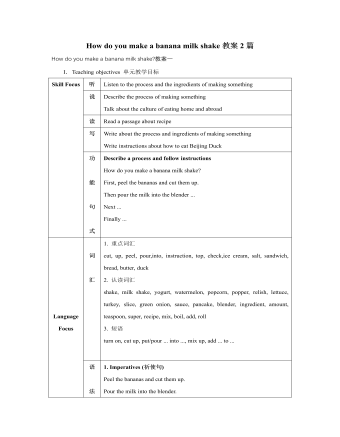
人教版新目标初中英语八年级上册How do you make a banana milk shake教案2篇
1. First, ... then, ... next, ... finally, ...首先,……然后,……接着,……最后,……这是英语中表达做某事的步骤的一种说法。如果步骤较多,还可以说:first-next-after that-later on-finally/at last通常你会听到说英语国家的人在说 first, next, then, finally 和后面的内容时,他们会做一些停顿。这样就能提前告诉听者接下来讲的是一系列的步骤。这一点在朗读和听力中应特别注意。2. how many, how much均为疑问词,同是“多少”,但用法不同。请看:how many修饰可数名词复数,how much修饰不可数名词。但在用法上,同学们常犯如下错误:1) [误] How many are there bananas on the table?[正] How many bananas are there on the table?[析] how many, how much 中的many,much是形容词,常修饰名词作定语,故后面跟名词。2) [误]How much tea are there on the table?[正]How much tea is there on the table?[析] how much修饰不可数名词时,谓语动词用单数。how many与how much的区别可简记为:前how many:问“多少”,复数名词后面跑;how much问“多少”,不可数名词单数好。前者答语用基数词,后者答语用数量关系。

人教版新目标初中英语八年级上册How do you get to school教案2篇
Step Ⅶ Role play ( Work on 1b)1. First ask two students to read the dialogue to the class.Sa: How do you get to school?Sb: Well, I ride my bike to the subway station. Then I take the subway.2. Now work with a partner.Suppose you use two kinds of transportation to get to school \Hangzhou\Beijing... (bus, train, subway, walking, bike, etc.) Tell how you get there. You may use the phrases in 1a.3. Then ask different pairs of students to present their conversations to the class.Step ⅧListening1. Work on 2a(1) First ask students to read the list of information that Thomas wants to know.…where Nina lives.…how far from school she lives.…how long it takes to get to school.…how she gets to school.…what she thinks of the transportation.(2) Tell students what transportation and bus stop mean.bus stop 汽车站 transportation n. 运送;运输Then tell students we'll hear a recording. Please put a checkmark in front of each thing that Thomas wants to know.(3) Now play the recording for students.( Have students pay attention to the sample answer.) (4) Then correct the answers.
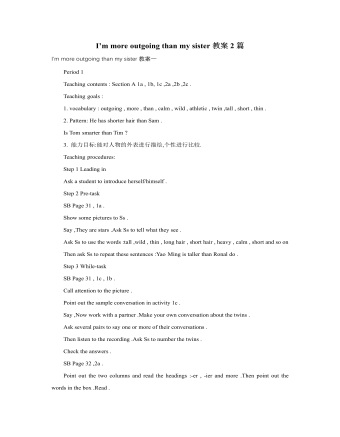
人教版新目标初中英语八年级上册I’m more outgoing than my sister教案2篇
1 交通工具的比较此活动为小组活动。学生通过讨论找出到达某一城市可乘坐的各种交通工具,并选择最佳出行方式。Teacher:We’re going to Shanghai. How many ways can we use to get there? Yes, there are four ways: by bus, by plane, by train, by ship. Please discuss how you are going to get there.操作建议:(1)学生以小组为单位展开活动,谈论本组所选择的交通工具。(2)各组选代表向全班汇报,阐述本组所选择的交通工具的利和弊。完成任务所需要的语言结构:We can go there by ship. It’s more comfortable and cheaper than any other transportation.We can go there by bus. It’s cheaper but it takes longer time.2 哪个城市更合适?此活动具有挑战性。假设中国要举行2014年世界杯足球赛,分别从历史,人文,天气等方面对各城市(北京,大连,上海,昆明)进行比较,选择最佳举办城市。T: Imagine China is holding the 2014 FIFA World Cup. Which city do you think is the best for the World Cup, Beijing, Dalian, Shanghai or Kunming? Let’s work in groups. If you choose Beijing, please join the Team Red. If you chose Dalian, please join the Team White. If you choose Shanghai, please join the Team Blue. If you choose Kunming, please join the Team Green. Please show us its advantages. Then let’s see which team will win.
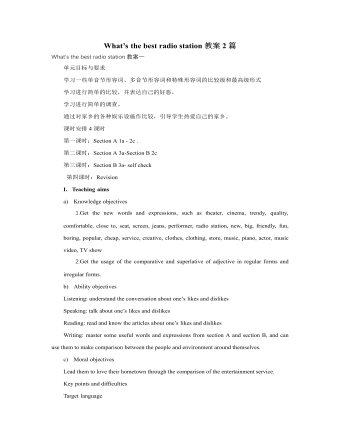
人教版新目标初中英语八年级上册What’s the best radio station教案2篇
教学重点和难点:运用所掌握的语言描述,比较不同地点的特点。在练习中学习掌握英语比较级和最高级的用法。课前准备分配小组,每组五至六人。通过上网或翻阅报刊杂志等方法,确定旅游线路,做出基本的旅游计划。教学设计:本节课流程图 学法指导:1.由于这是一堂新课,在教学中应注意面向全体,发挥学生的主体性,引导学生积极参与,激发学生的求知欲和学习积极性,指导学生积极思维,主动获取知识,养成良好的学习方法。逐步学会独立解决问题。总之要尽可能调动学生的非智力因素促进智力因素的发展。教法选择:1.电化教学法2.课堂讨论法3.任务型教学法采用这些方法的目的是为了充分调动学生的学习积极性,使学生变被动学习为主动学习。通过电脑形象的演示,加强印象,提高兴趣,突破难点,提高教学效率,进而增大教学的容量和信息量。充分体现教师为主导,学生为主体的教学原则。

人教版新目标初中英语八年级上册What’s the matter教案2篇
She shouldn’t go to the party tonight.Step7. TaskT: You know, there are lots of problems in our life. If you are a doctor, please tell us how to solve the problem. I will divide you into 9 groups. Please work in groups. And then choose one of you to report your ideas.The following are the problems:I have a toothache.I am hungry. I have a sore throat.I am stressed out. I have a sore back.I am tired. I can’t sleep.I have a cold. I have a headache.Report: If you have a headache, you should go to bed early. You should see the doctor. You should eat some medicine. You shouldn’t wash your face with cold water.You shouldn’t sleep late.You shouldn’t swim.…..T encourages the students to give advice as much as possible.Homework:1. Chose one of the problems, and write down your advice2. Copy the new words这一步是用于热身的,同时也可以让他们复习一部分的表示人体部位的单词,扩充知识.学习语言的过程也是一个不断积累的过程,复习旧知识,增添新知识.通过小游戏,强化学生对Does she/he have…这个句子的运用能力.通过复习,自然的引到下面新知识的学习。充分利用表格,由句子到对话,再到文章,让学生循序渐进. 提高学生的综合语言运用能力,运用以前学过的知识来解决身边的问题.Period 5 (Section B 3a—3c, selfcheck)教学内容与分析:
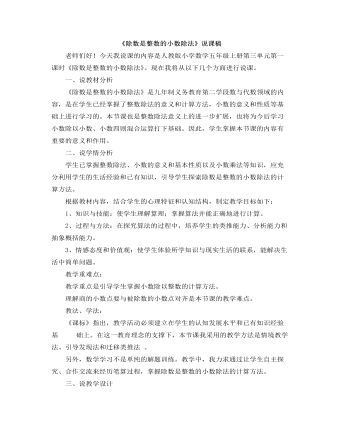
小学数学人教版五年级上册《除数是整数的小数除法》说课稿
一、说教材分析 《除数是整数的小数除法》是九年制义务教育第二学段数与代数领域的内容,是在学生已经掌握了整数除法的意义和计算方法,小数的意义和性质等基础上进行学习的。本节课也是整数除法意义上的进一步扩展,也将为今后学习小数除以小数、小数四则混合运算打下基础。因此,学生掌握本节课的内容有重要的意义和作用。 二、说学情分析学生已掌握整数除法、小数的意义和基本性质以及小数乘法等知识,应充分利用学生的生活经验和已有知识,引导学生探索除数是整数的小数除法的计算方法。 根据教材内容,结合学生的心理特征和认知结构,制定教学目标如下: 1、知识与技能:使学生理解算理;掌握算法并能正确地进行计算。 2、过程与方法:在探究算法的过程中,培养学生的类推能力、分析能力和抽象概括能力。 3、情感态度和价值观:使学生体验所学知识与现实生活的联系,能解决生活中简单问题。
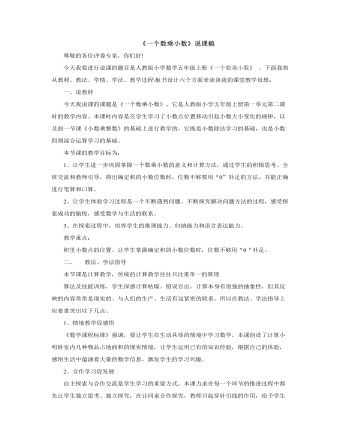
小学数学人教版五年级上册《一个数乘小数》说课稿
一、说教材今天我说课的课题是《一个数乘小数》。它是人教版小学五年级上册第一单元第二课时的教学内容。本课时内容是在学生学习了小数点位置移动引起小数大小变化的规律,以及前一节课《小数乘整数》的基础上进行教学的,它既是小数除法学习的基础,也是小数四则混合运算学习的基础。本节课的教学目标为:1、让学生进一步巩固掌握一个数乘小数的意义和计算方法,通过学生的积极思考、全班交流和教师引导,得出确定积的小数位数时,位数不够要用“0”补足的方法。并能正确进行笔算和口算。2、让学生体验学习过程是一个不断遇到问题、不断探究解决问题方法的过程,感受探索成功的愉悦,感受数学与生活的联系。3、在探索过程中,培养学生的推理能力、归纳能力和语言表达能力。
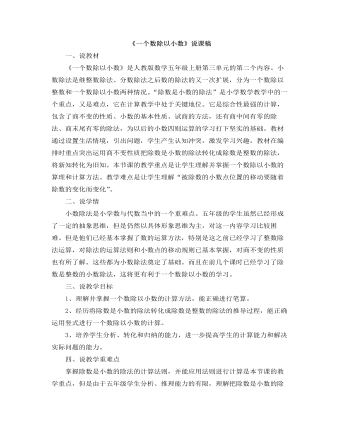
小学数学人教版五年级上册《一个数除以小数》说课稿
一、说教材《一个数除以小数》是人教版数学五年级上册第三单元的第二个内容。小数除法是继整数除法、分数除法之后数的除法的又一次扩展,分为一个数除以整数和一个数除以小数两种情况。“除数是小数的除法”是小学数学教学中的一个重点,又是难点,它在计算教学中处于关键地位。它是综合性最强的计算,包含了商不变的性质、小数的基本性质、试商的方法,还有商中间有零的除法、商末尾有零的除法,为以后的小数四则运算的学习打下坚实的基础。教材通过设置生活情境,引出问题,学生产生认知冲突,激发学习兴趣。教材在编排时重点突出运用商不变性质把除数是小数的除法转化成除数是整数的除法,将新知转化为旧知。本节课的教学重点是让学生理解并掌握一个数除以小数的算理和计算方法。教学难点是让学生理解“被除数的小数点位置的移动要随着除数的变化而变化”。
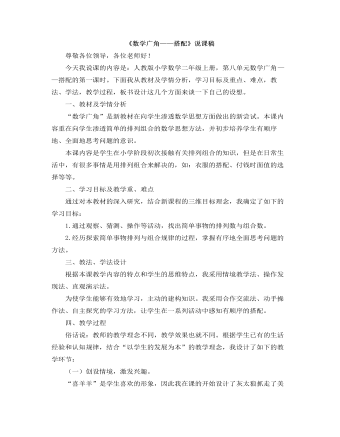
小学数学人教版二年级上册《数学广角——搭配》说课稿
一、教材及学情分析“数学广角”是新教材在向学生渗透数学思想方面做出的新尝试。本课内容重在向学生渗透简单的排列组合的数学思想方法,并初步培养学生有顺序地、全面地思考问题的意识。本课内容是学生在小学阶段初次接触有关排列组合的知识,但是在日常生活中,有很多事情是用排列组合来解决的,如:衣服的搭配、付钱时面值的选择等等。二、学习目标及教学重、难点通过对本教材的深入研究,结合新课程的三维目标理念,我确定了如下的学习目标:1.通过观察、猜测、操作等活动,找出简单事物的排列数与组合数。2.经历探索简单事物排列与组合规律的过程,掌握有序地全面思考问题的方法。三、教法、学法设计根据本课教学内容的特点和学生的思维特点,我采用情境教学法、操作发现法、直观演示法。为使学生能够有效地学习,主动的建构知识。我采用合作交流法、动手操作法、自主探究的学习方法,让学生在一系列活动中感知有顺序的搭配。
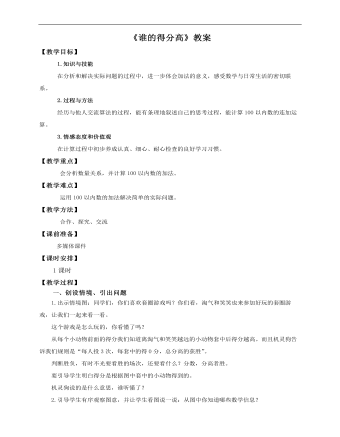
小学数学北师大版二年级上册《第一课谁的得分高》教案说课稿
2.过程与方法经历与他人交流算法的过程,能有条理地叙述自己的思考过程,能计算100以内数的连加运算。3.情感态度和价值观在计算过程中初步养成认真、细心、耐心检查的良好学习习惯。【教学重点】 会分析数量关系,并计算100以内数的加法。【教学难点】 运用100以内数的加法解决简单的实际问题。【教学方法】 合作、探究、交流【课前准备】 多媒体课件【课时安排】 1课时【教学过程】一、创设情境、引出问题1.出示情境图:同学们,你们喜欢套圈游戏吗?你们看,淘气和笑笑也来参加好玩的套圈游戏,让我们一起来看一看。这个游戏是怎么玩的,你看懂了吗?从每个小动物前面的得分我们知道离淘气和笑笑越远的小动物套中后得分越高。而且机灵狗告诉我们规则是“每人投3次,每套中的得0分,总分高的获胜”。判断胜负,有时不光要看胜的场次,还要看什么?分数,分高者胜。要引导学生明白得分是根据图中套中的小动物得到的。机灵狗说的是什么意思,谁听懂了?2.引导学生有序观察图意,并让学生看图说一说:从图中你知道哪些数学信息?
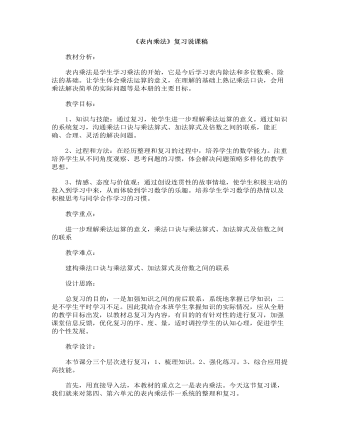
小学数学人教版二年级上册《表内乘法》复习说课稿
教学目标:1、知识与技能:通过复习,使学生进一步理解乘法运算的意义。通过知识的系统复习,沟通乘法口诀与乘法算式、加法算式及倍数之间的联系,能正确、合理、灵活的解决问题。2、过程和方法:在经历整理和复习的过程中,培养学生的数学能力。注重培养学生从不同角度观察、思考问题的习惯,体会解决问题策略多样化的教学思想。3、情感、态度与价值观:通过创设连贯性的故事情境,使学生积极主动的投入到学习中来,从而体验到学习数学的乐趣。培养学生学习数学的热情以及积极思考与同学合作学习的习惯。教学重点:进一步理解乘法运算的意义,乘法口诀与乘法算式、加法算式及倍数之间的联系教学难点:建构乘法口诀与乘法算式、加法算式及倍数之间的联系

小学数学人教版二年级上册《认识锐角和钝角》说课稿
二、说教学目标知识和技能:能结合生活情景辨认锐角和钝角,能口述锐角和钝角的特征。 过程和方法:通过观察、操作、分类、比较等数学教学活动,培养学生的动手能力,合作意识,激发学生的创新思维。在对简单物体和图形的形状的探索过程中,发展空间观念。情感、态度、价值观:通过实践,使学生获得成功的体验,建立自信心。通过生活情境的创设,感受生活中处处有数学,培养学习数学的兴趣。教学重点:能辨认锐角、钝角。知道锐角、钝角的特征。教学难点:能辨认锐角、钝角。三、说教法、学法这一节课的教学对象是二年级的学生。他们年龄小、好动、爱玩、好奇心强,在四十分钟的教学中容易疲劳,注意力容易分散。根据这一特点,为了抓住他们的兴趣,激发他们的好奇心,我采用了愉快式教学方法为主,创设情境,设计了生动有趣的简笔画,让学生在图所创设的情境中学习。同时我还采用了动像发现教学法,让孩子们通过合作交流去发现角和展示角,这样既活跃了学生的思想,激发了认知兴趣,而且充分发挥学生的学习积极性。





















